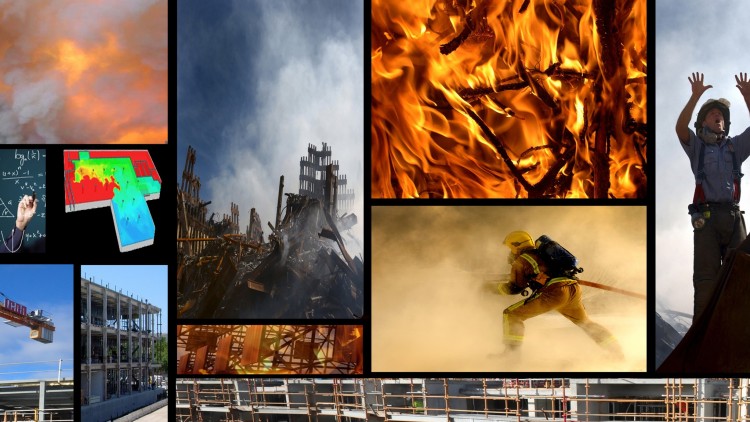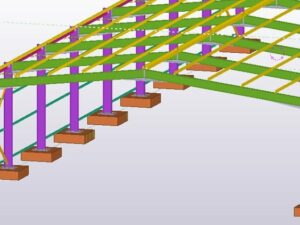Fire Analysis of Steel Structures according to Eurocodes
- Description
- Curriculum
- FAQ
- Reviews

Fire resistance of building structure« means the ability of the structure exposed to fire the appropriate time maintaining its strength. To recognize the precise value of the duration in which the construction retains its capacity, is crucial for fire-resistant design. Fire analysis calculation takes into account the actual technical state of construction material exposed to thermal impact or fire load and provide you with the critical temperature, e.g. the temperature to which the structure maintains its capacity or advice you of the optimal fire protection of the structural elements.
Why must we learn Fire Analysis?
Because we do not want that we have fire protection, which is oversized and as well uneconomical. On the other hand we do not want that the construction is in fire risk and does not allow a safe evacuation, as well as fire extinguishing and rescue.
Course Structure
In this course, I will present a thorough overview of structural fire analysis according to nominal temperature-time curves according to Eurocodes.
We will learn the following topics:
– What is thermal action?
– How to calculate temperature of protected and unprotected steel sections
– How to create load combinations for the fire limit states
– How to calculate fire resistance of structural members and their critical temperature
– Fire protection systems for steel structures
All chapters will also provide you with worked examples which will cover theoretical part presented. At the end you will be presented a calculation of critical temperature and required fire protection for typical structural elements of real structure.
I will provide you with an easy-to-follow material explanation, each section is clearly demonstrated in the presentation and covered with worked examples.
-
2Thermal Action
In this lesson we will learn what is thermal action and how we consider the fire action on the structure. It will be clearly described what kind of nominal temperature-time curves are covered in Eurocodes and how they can be applied to structure.
-
3Heat Transfer Mechanisms
In this lesson we will learn how is the heat from fire compartment transferred to the structural element. We will learn three important topics here:
- Section factor
- Temperature of unprotected steel sections
- Temperature of protected steel sections
-
4Section Factor
In this lesson we will learn what is the section factor and why it is so important to know it for the evaluation of the speed of heating up. We will see how it differs in unprotected and protected cross sections.
-
5Temperature of Unprotected Steel Sections
In this lesson we will learn how to calculate the increase in temperature in unprotected steel element according to Eurocodes. Numerical procedure for this calculation will be clearly presented, including detailed description of all parameters and worked example.
-
6Temperature of Protected Steel Sections
In this lesson we will learn how to calculate the increase in temperature in protected steel element according to Eurocodes. Numerical procedure for this calculation will be clearly presented, including detailed description of all parameters and their limitations. Additionally worked example will be calculated.
-
7Load Combinations
In this lesson we will learn how to define fire load combination and which safety factors can be used for particular load case. We will learn general rule and simplified rule for calculating effects of actions for fire load combination. Additionally worked example will be presented.
-
8Introduction to Mechanical Analysis
In this lesson we will learn fire analysis using strength and temperature domain. Reduction factors for yield strength and Young's modulus at elevated temperature will be described in detail.
-
9Classification of Cross Sections
In this lesson we will repeat cross section classification from designing steel structures at room temperature and describe what is different in cross section classification at elevated temperature. Additionally worked examples will be presented for all four classes of cross sections.
-
10Tension Members
In this lesson we will learn the calculation of the design resistance of the tension member at elevated temperature. Additionally worked example will be calculated.
-
11Compression Members
In this lesson we will learn the calculation of the design resistance of the compression member with classes 1,2,3 at elevated temperature. Additionally worked example will be calculated.
-
12Shear Members
In this lesson we will learn the calculation of the design shear resistance of a member with classes 1,2,3 at elevated temperature. Additionally worked example will be calculated.
-
13Bending Members
In this lesson we will learn the calculation of the design moment resistance of a member with classes 1,2,3 at elevated temperature. Non-uniform temperature distribution will be explained too. Additionally worked example will be calculated.
-
14Combined Bending and Shear
In this lesson we will learn the calculation of the reduced design moment resistance of a member with classes 1,2,3 at elevated temperature for combined bending and shear acting together . Non-uniform temperature distribution will be explained too. Additionally worked example will be calculated.
-
15Combined Bending and Axial Force
In this lesson we will learn the calculation of the reduced design moment resistance of a member with classes 1,2,3 at elevated temperature for combined bending and axial force acting together. Additionally worked example will be calculated.
-
16Critical Moment for LTB
In this lesson we will learn the calculation of the critical moment for lateral torsional for uniform symetrical cross sections. Additionally worked example will be calculated.
-
17Lateral Torsional Buckling
In this lesson we will learn the calculation of the design lateral torsional buckling moment resistance of a member with classes 1,2,3 at elevated temperature. Additionally worked example will be calculated.
-
18Combined Bending and Axial Compression
In this lesson we will learn the calculation of the design resistance for members with classes 1,2,3 subjected to combined bending and axial compression at elevated temperature. Additionally worked example will be calculated.
-
19Members with Class 4 Cross Sections
In this lesson we will learn the calculation of the design resistance for members with class 4 at elevated temperature. Additionally worked example will be calculated.
-
20Critical Temperature Calculation
In this lesson we will learn the calculation of critical temperature for tension and bending elements. Additionally worked example will be calculated.
-
21Iterative Procedure at Critical Temperature Caluclation
In this lesson we will learn the calculation of critical temperature when iterative procedure is required. Additionally worked example will be calculated.
-
22Fire Protection Systems
In this lesson we will learn when fire protection is needed and which systems can be used for fire protection. We will learn also how to consider moisture in insulation.
-
23Calculation of Fire Protection
In this lesson we will learn how to calculate fire protection and which parameters should be taken very carefully to get accurate results
-
24Structure Definition
In this lesson we will present the structure definition, actions on structure and description of typical structural elements which will be checked in fire analysis.
-
25Main Beams
In this lesson we will calculate critical temperature and actual temperature for main beams. We will calculate also fire protection as critical temperature is reached very early and just unprotected steel section does not provide required fire resistance.
-
26Secondary Beams
In this lesson we will calculate critical temperature and actual temperature for secondary beams. We will calculate also fire protection as critical temperature is reached very early and just unprotected steel section does not provide required fire resistance.
-
27Columns
In this lesson we will calculate critical temperature and actual temperature for columns. As actual temperature is less than critical temperature after 30 minutes, no fire protection is needed.
-
28Analysis of Results - Conclusions
In this lesson we will analyse the results of calculation. We will compare the results of fire analysis with default value of critical temperature which is usually used in many countries without knowing the exact value of the critical temperature for typical structural elements. Finally we will learn why it is so important to know the exact value of the critical temperature for optimal and safe fire design.






Social Network